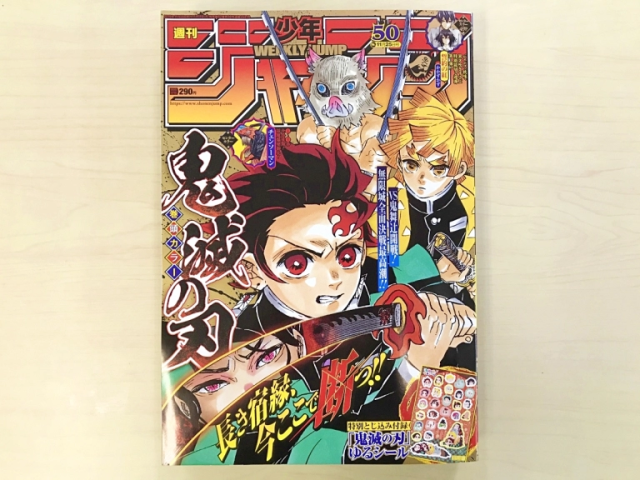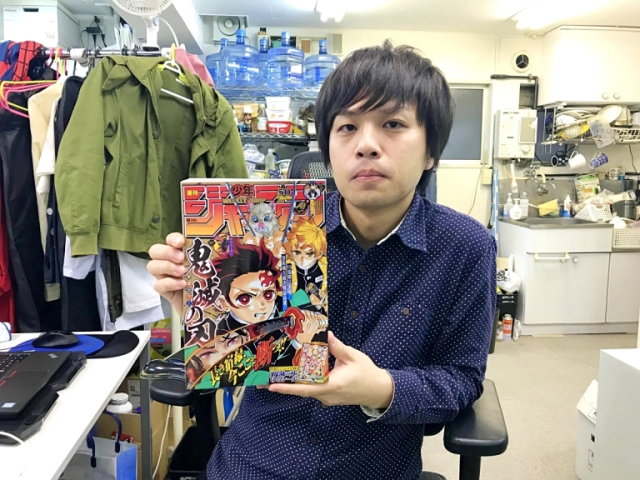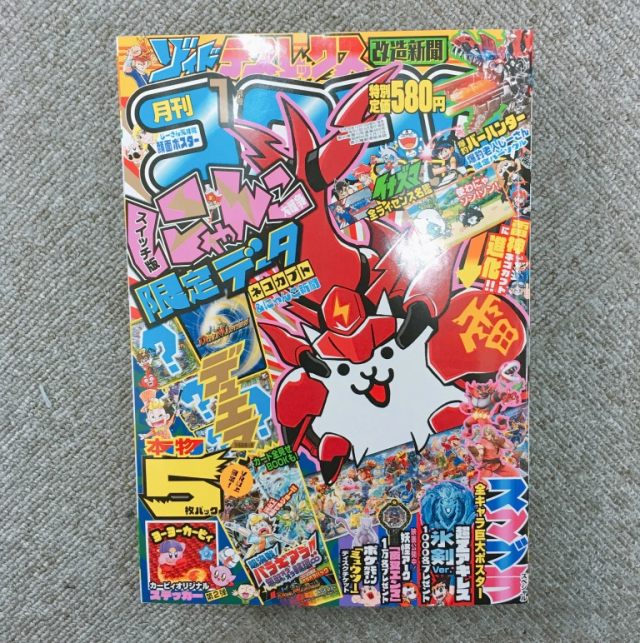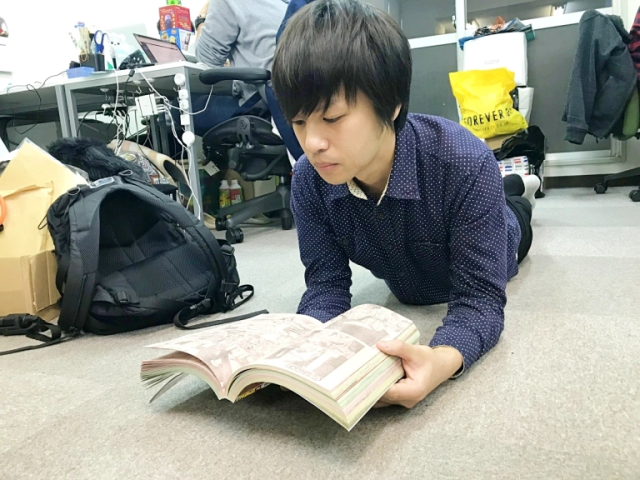
Weekly Shonen Jump’s name might not be entirely accurate, so our in-house fan offers an alternative.
Japan’s best-selling manga anthology is, and for many years has been, Weekly Shonen Jump. The one Japanese word in the title, shonen, is written with the kanji 少年, which literally mean “small life,” but more accurately the term translates to “boy.”
As such, Weekly Shonen Jump is largely seen as the standard-bearer for for-boys comics in Japan, but a recent tweet from Twitter user @jyaricat has some people questioning whether the term on the cover actually matches the reader demographics.
ちょっと今日考えさせられた会話
— じゃりねこ (@jyaricat) November 9, 2019
私「……でね、子供に影響を与えないように、ジャンプでそういう漫画を……」
小6女子「少年ジャンプって大人が読む漫画でしょ?」
私「えっ」
小「だって買ってるの大人ばっかりだよ」
「クラスの男子誰も買ってないよ」「私はお父さんの読んでるけど」
私「ええー」
“Had a thought-provoking conversation today.
Me: “…so, in order not to be a bad influence on children, with that kind of manga, what Jump does is…”
My daughter, who’s in the sixth year of elementary school: “Shonen Jump manga are manga that adults read, aren’t they?”
Me: “What?”
Daughter “I mean, adults are the only ones who buy it. None of the boys in my class buy it, and I read the copy that you buy.”
Me: “Whaaaa…”
Getting back to @jyaricat’s initial tweet, the father went on to point out that some anime based on Weekly Shonen Jump manga air at times when young boys probably aren’t going to be able to watch them. Dr. Stone, for example, comes on at 10 p.m., and Demon Slayer: Kimetsu no Yaiba at 11:30 p.m., well past most young kids’ bedtimes.
This got one of our in-house manga fans, Japanese-language reporter Ahiru Neko, thinking too. Is Weekly Shonen Jump really for shonen?
Let’s turn it over to Ahiru Neko:
“For me, when I think of the word ‘shonen,’ I think of someone who’s still a child. I guess I’d start using the word for a kid who’s started elementary school…but if they’re still in like the first or second grade, they’re more like ‘toddlers’ than ‘boys,’ I think. So, really, the start of being a shonen, to me, is around the third or fourth year of elementary school.”
“When I think back to when I was growing up, I hardly ever read Jump when I was in elementary school. It wasn’t until I was part-way through the sixth grade [the last year of elementary school in Japan] that I started buying the new issue every week, and before that, not just me, but my classmates too, were more likely to buy manga magazines aimed at younger readers, like Korokoro Comic or Bonbon.
▼ Korokoro Comic
“When I was in elementary school, I loved series like Dragon Ball, Yu Yu Hakusho, and Slam Dunk. But for all of them, it was their TV anime adaptations that I followed. I hardly recall ever reading the original manga, and even if I did, it was in one of the collected volumes, not in the weekly Jump installments. When I was in elementary school, I think I always thought of Weekly Shonen Jump manga as something that was written for people older than me.”
“Looking back, there really weren’t that many elementary-school kids who bought Weekly Shonen Jump, and people didn’t really get serious about reading it until they got a little older, in middle school…maybe it would be more accurate to call the magazine “Shonen and Older Jump.”
Photos ©SoraNews24
● Want to hear about SoraNews24’s latest articles as soon as they’re published? Follow us on Facebook and Twitter!
[ Read in Japanese ]




 Weekly Shonen Jump teams up with Georgia to bring us limited-edition manga-printed coffee cans
Weekly Shonen Jump teams up with Georgia to bring us limited-edition manga-printed coffee cans In Japan, Uber Eats will deliver the latest manga to your door
In Japan, Uber Eats will deliver the latest manga to your door A Gintama fan’s emotional 19-year journey to buy a proper Lake Toya bokuto wooden katana【Pics】
A Gintama fan’s emotional 19-year journey to buy a proper Lake Toya bokuto wooden katana【Pics】 Jump Festa 2023 to be livestreamed around the world for first time ever
Jump Festa 2023 to be livestreamed around the world for first time ever One Piece manga sends off Naruto with a classy secret message
One Piece manga sends off Naruto with a classy secret message McDonald’s new Happy Meals offer up cute and practical Sanrio lifestyle goods
McDonald’s new Happy Meals offer up cute and practical Sanrio lifestyle goods All-you-can-drink Starbucks and amazing views part of Tokyo’s new 170 meter-high sky lounge
All-you-can-drink Starbucks and amazing views part of Tokyo’s new 170 meter-high sky lounge Studio Ghibli glasses cases let anime characters keep an eye on your spectacles
Studio Ghibli glasses cases let anime characters keep an eye on your spectacles More foreign tourists than ever before in history visited Japan last month
More foreign tourists than ever before in history visited Japan last month Kyoto’s 100 Demons yokai monster parade returns!
Kyoto’s 100 Demons yokai monster parade returns! Beautiful Sailor Moon manhole cover coasters being given out for free by Tokyo tourist center
Beautiful Sailor Moon manhole cover coasters being given out for free by Tokyo tourist center Starbucks reopens at Shibuya Scramble Crossing with new look and design concept
Starbucks reopens at Shibuya Scramble Crossing with new look and design concept Mister Donut ready to make hojicha dreams come true in latest collab with Kyoto tea merchant
Mister Donut ready to make hojicha dreams come true in latest collab with Kyoto tea merchant Hamster abandoned at Tokyo ramen restaurant gets new home
Hamster abandoned at Tokyo ramen restaurant gets new home The oldest tunnel in Japan is believed to be haunted, and strange things happen when we go there
The oldest tunnel in Japan is believed to be haunted, and strange things happen when we go there Disney princesses get official manga makeovers for Manga Princess Cafe opening in Tokyo
Disney princesses get official manga makeovers for Manga Princess Cafe opening in Tokyo Beautiful new Final Fantasy T-shirt collection on the way from Uniqlo【Photos】
Beautiful new Final Fantasy T-shirt collection on the way from Uniqlo【Photos】 Is the new Shinkansen Train Desk ticket worth it?
Is the new Shinkansen Train Desk ticket worth it? Foreign English teachers in Japan pick their favorite Japanese-language phrases【Survey】
Foreign English teachers in Japan pick their favorite Japanese-language phrases【Survey】 Japanese convenience store packs a whole bento into an onigiri rice ball
Japanese convenience store packs a whole bento into an onigiri rice ball We try out “Chan Ramen”, an underground type of ramen popular in the ramen community
We try out “Chan Ramen”, an underground type of ramen popular in the ramen community Studio Ghibli releases Kiki’s Delivery Service chocolate cake pouches in Japan
Studio Ghibli releases Kiki’s Delivery Service chocolate cake pouches in Japan Japan’s bone-breaking and record-breaking roller coaster is permanently shutting down
Japan’s bone-breaking and record-breaking roller coaster is permanently shutting down New definition of “Japanese whiskey” goes into effect to prevent fakes from fooling overseas buyers
New definition of “Japanese whiskey” goes into effect to prevent fakes from fooling overseas buyers Our Japanese reporter visits Costco in the U.S., finds super American and very Japanese things
Our Japanese reporter visits Costco in the U.S., finds super American and very Japanese things Studio Ghibli unveils Mother’s Day gift set that captures the love in My Neighbour Totoro
Studio Ghibli unveils Mother’s Day gift set that captures the love in My Neighbour Totoro Foreign passenger shoves conductor on one of the last full runs for Japan’s Thunderbird train
Foreign passenger shoves conductor on one of the last full runs for Japan’s Thunderbird train Domino’s Japan now sells…pizza ears?
Domino’s Japan now sells…pizza ears? New Japanese KitKat flavour stars Sanrio characters, including Hello Kitty
New Japanese KitKat flavour stars Sanrio characters, including Hello Kitty Kyoto creates new for-tourist buses to address overtourism with higher prices, faster rides
Kyoto creates new for-tourist buses to address overtourism with higher prices, faster rides Sales of Japan’s most convenient train ticket/shopping payment cards suspended indefinitely
Sales of Japan’s most convenient train ticket/shopping payment cards suspended indefinitely Sold-out Studio Ghibli desktop humidifiers are back so Totoro can help you through the dry season
Sold-out Studio Ghibli desktop humidifiers are back so Totoro can help you through the dry season Japanese government to make first change to romanization spelling rules since the 1950s
Japanese government to make first change to romanization spelling rules since the 1950s Ghibli founders Toshio Suzuki and Hayao Miyazaki contribute to Japanese whisky Totoro label design
Ghibli founders Toshio Suzuki and Hayao Miyazaki contribute to Japanese whisky Totoro label design Doraemon found buried at sea as scene from 1993 anime becomes real life【Photos】
Doraemon found buried at sea as scene from 1993 anime becomes real life【Photos】 Tokyo’s most famous Starbucks is closed
Tokyo’s most famous Starbucks is closed One Piece characters’ nationalities revealed, but fans have mixed opinions
One Piece characters’ nationalities revealed, but fans have mixed opinions We asked a Uniqlo employee what four things we should buy and their suggestions didn’t disappoint
We asked a Uniqlo employee what four things we should buy and their suggestions didn’t disappoint Princesses, fruits, and blacksmiths: Study reveals the 30 most unusual family names in Japan
Princesses, fruits, and blacksmiths: Study reveals the 30 most unusual family names in Japan Breaking Fujoshi: Twitter user tries to unlock the code to girls who grow up “rotten”
Breaking Fujoshi: Twitter user tries to unlock the code to girls who grow up “rotten” Half-dozen of manga’s greatest creators have at-home drinking party, make one-of-a-kind artwork
Half-dozen of manga’s greatest creators have at-home drinking party, make one-of-a-kind artwork Demon Slayer manga creator offers a motivational illustration during the pandemic
Demon Slayer manga creator offers a motivational illustration during the pandemic Animate Akihabara dispels misunderstanding that it will stop selling manga for adult men
Animate Akihabara dispels misunderstanding that it will stop selling manga for adult men Oh, it turns out manga creator Rumiko Takahashi’s schedule is EVEN CRAZIER than we thought!
Oh, it turns out manga creator Rumiko Takahashi’s schedule is EVEN CRAZIER than we thought! Honda Fit and Weekly Shonen Jump magazine create stunning Japanese itasha manga car【Pics】
Honda Fit and Weekly Shonen Jump magazine create stunning Japanese itasha manga car【Pics】 Expectations run high as Death Note team begins new series — this time about angels!
Expectations run high as Death Note team begins new series — this time about angels! Believe it! Naruto’s creator Masashi Kishimoto comments on plans for new manga at New York event
Believe it! Naruto’s creator Masashi Kishimoto comments on plans for new manga at New York event We coordinate a head-to-toe look for just 1,000 yen
We coordinate a head-to-toe look for just 1,000 yen Shonen Jump’s anime heroes punch huge craters in Shinjuku Station, create photo spots
Shonen Jump’s anime heroes punch huge craters in Shinjuku Station, create photo spots Hang onto your handles, because a Yowamushi Pedal live-action drama is coming this summer!
Hang onto your handles, because a Yowamushi Pedal live-action drama is coming this summer! Goku down! Vast majority of surveyed college students in Japan haven’t read the Dragon Ball manga
Goku down! Vast majority of surveyed college students in Japan haven’t read the Dragon Ball manga Naruto’s son gets a voice as lead roles cast for Boruto –Naruto the Movie-
Naruto’s son gets a voice as lead roles cast for Boruto –Naruto the Movie- Japanese elementary schools’ list of behavior requirements would be hard for most adults to clear
Japanese elementary schools’ list of behavior requirements would be hard for most adults to clear Girls manga magazine comes with cool perfume mixing set, puzzling beauty advice columns
Girls manga magazine comes with cool perfume mixing set, puzzling beauty advice columns
Leave a Reply